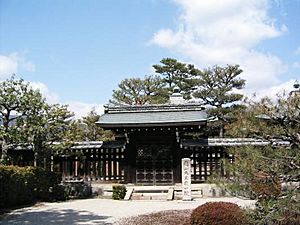Emperor Kameyama facts for kids
Quick facts for kids Emperor Kameyama亀山天皇 |
|||||
|---|---|---|---|---|---|
 |
|||||
| Emperor of Japan | |||||
| Reign | 9 January 1260 – 6 March 1274 | ||||
| Coronation | 10 February 1260 | ||||
| Predecessor | Go-Fukakusa | ||||
| Successor | Go-Uda | ||||
| Shōgun | |||||
| Born | 9 July 1249 | ||||
| Died | 4 October 1305 (aged 56) Mansion of Kameyama-dono (亀山殿邸), Heian Kyō |
||||
| Burial | Kameyama no Misasagi (亀山陵) (Kyoto) | ||||
| Spouse |
|
||||
| Issue Among others... |
Emperor Go-Uda | ||||
|
|||||
| House | Yamato | ||||
| Father | Emperor Go-Saga | ||||
| Mother | Fujiwara no Kitsushi | ||||
| Signature |  |
||||
Emperor Kameyama (亀山天皇, Kameyama-tennō, 9 July 1249 – 4 October 1305) was the 90th emperor of Japan. He ruled from 1260 to 1274.
Contents
Becoming Emperor Kameyama
Before he became emperor, his personal name was Tsunehito-shinnō (恒仁親王). He was the seventh son of Emperor Go-Saga.
Emperor Kameyama had two main empresses:
- Toin (Fujiwara Saneko)
- Saionji (Fujiwara) Kishi
His second son, Imperial Prince Yohito, later became Emperor Go-Uda.
In 1258, when he was 9 years old, Tsunehito became the Crown Prince.
Emperor Kameyama had a few other names during his life:
- Kongogen (金剛源) was his name when he became a Buddhist monk.
- Zenrinji-dono (禅林寺殿) means "Lord Zen-Temple." This name came from a Zen temple he built at his Imperial Villa.
- Madenokō-ji-dono was another name from his home.
- Bun'ō Kōtei came from the name of the era he ruled in.
The name Kameyama itself comes from where his tomb is located.
Key Events During His Reign
On 9 January 1260, Emperor Go-Fukakusa stepped down from the throne. His younger brother, Tsunehito, then became the new emperor, known as Emperor Kameyama.
In 1263, there was a change in the shōgun (the military ruler of Japan). Prince Munetaka, who was the shōgun, was replaced by his young son, Prince Koreyasu, who was only 2 years old.
In 1265, a group of people sent by Kublai Khan, the powerful ruler of the Mongol Empire, arrived in Japan. On their way, they had stolen things from islands. The Mongols wanted Japan to become part of Kublai Khan's empire. Emperor Kameyama and his court thought about trying to find a peaceful solution. However, the shōgun in Kamakura (the military government) ignored their ideas and sent the Mongol group away.
Life as a Cloistered Emperor
In 1274, Emperor Kameyama decided to step down from the throne. His son, Emperor Go-Uda, became the new emperor. Even though he was no longer the official emperor, Kameyama continued to have power and influence as a cloistered emperor. This meant he still guided the government from behind the scenes.
During his time as a cloistered emperor, the Mongols tried to invade Japan a second time. This was a very serious threat. Emperor Kameyama went to the Grand Shrine of Ise to pray for Japan's safety. On 15 August 1281, he asked the sun goddess Amaterasu to help protect Japan from the invaders.
However, the Bakufu (the military government) started to suspect Emperor Kameyama. In 1287, they encouraged Emperor Go-Uda to step down. They then pushed for the son of Emperor Go-Fukakusa to become the new emperor, who was named Emperor Fushimi. This change meant that Kameyama's power as a cloistered emperor was stopped.
Later, Prince Hisaaki, another son of Emperor Go-Fukakusa, became the shōgun. This made the position of the Jimyōin-tō (a rival imperial family line) much stronger. Kameyama felt very sad about these events. In 1289, he decided to become a Buddhist monk and joined the Zen group. Because of his decision, Zen Buddhism slowly became more popular among the nobles at the court.
In 1291, he helped to create the Buddhist temple Nanzen-ji in Kyōto.
Emperor Kameyama died in 1305. His tomb, called Kameyama no Misasagi, is located at Tenryū-ji in Kyoto. The Imperial Household Agency still takes care of this important burial site today.
Important Court Officials
The Kugyō (公卿) was a special group of the most powerful men who worked for the emperor in ancient Japan. Even when the emperor's actual power was not very strong outside the palace, this group of high-ranking officials still existed.
This elite group usually had only three or four men at a time. They were nobles who inherited their positions, and their experience helped them reach the highest levels of their careers. During Emperor Kameyama's reign, some of the important Kugyō roles included:
- Kampaku: This was a chief advisor to the emperor.
- Sadaijin: The Minister of the Left.
- Udaijin: The Minister of the Right.
- Nadaijin: The Minister of the Center.
- Dainagon: A chief councilor.
Eras During His Rule
The years of Emperor Kameyama's reign are also known by different era names or nengō. These eras helped people keep track of time.
See also
 In Spanish: Kameyama Tennō para niños
In Spanish: Kameyama Tennō para niños
- Emperor of Japan
- List of Emperors of Japan
- Imperial cult
- Emperor Go-Kameyama



